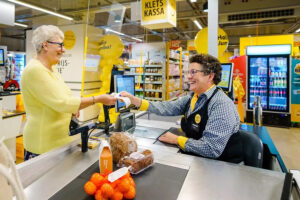5-second shopping: TikTok’s e-commerce ambitions are rising
High school graduates, Harry Potter, superheroes — Fredi Lugina Priadi can clothe a cat to look like almost anything.
Fredi became a social media phenomenon in 2020, with his clips of waddling, costumed cats drawing tens of millions of views on TikTok. He normally uses the e-commerce platform Shopee to sell his handmade pet clothing, but when he noticed in November that a TikTok shopping function had appeared, he immediately opted in.
“I make content firstly for entertainment, for laughs,” said Fredi. From his home in the Bogor area south of Indonesia’s capital Jakarta, his content reaches a following of almost half a million. “[But] actually, it’s a good opportunity that TikTok has opened for small businesses like me, for craftsmen.”
TikTok was one of the most downloaded apps of 2021 in Southeast Asia, according to Data.ai. Since February of that year, parent company ByteDance has been attempting to extend its exploding popularity into e-commerce by piloting TikTok Shop with entrepreneurs like Fredi in Indonesia, as well as in the U.K. A separate push is underway in the U.S. In February this year, ByteDance announced it would expand the function across Thailand, Vietnam, and Malaysia.
While Southeast Asia has its own e-commerce giants – Alibaba-backed Lazada, Sea-owned Shopee – ByteDance has positioned TikTok Shop as the next evolution in online shopping: more addictive for being powered by TikTok’s algorithm, and more entertaining for being layered onto its infinite scroll of short videos. Using TikTok Shop, sellers add a shopping tab to their existing TikTok feeds, enabling shoppers to browse without leaving the kinetic grid of the app.
In order to become a shopping destination, however, experts told Rest of World, TikTok Shop will not only have to confront the same challenges as incumbent e-commerce players – like complicated logistics and uneven adoption of electronic payments – but also convince small business owners that they can be short-video superstars, and persuade consumers to see the app as more than just entertainment.

“There’s a lot of fundamental room for growth for TikTok in relation to the e-commerce platforms [in Southeast Asia],” said Kok Seng Kiong, lecturer in finance at RMIT University in Ho Chi Minh City. “The main question is whether that actually translates into any form of relevant sales.”
Fredi told Rest of World that, throughout the pilot, he has continued to use TikTok primarily as an entertainment platform – and that his neighbors are, likewise, still surprised to find out they can shop on their favorite short video app. “Even though we have a store, people don’t know about it,” he said, having mainly sold on Shopee and Facebook for the past four years. On a recent video that’s drawn over 3 million views, one of the top comments urges: “Drop the link to your Shopee page, bro.”
Southeast Asia’s e-commerce market, with the potential to reach $1 trillion in size, according to a recent report by Google, has long drawn e-commerce companies looking for their next big audience. Though it varies by country, Shopee accounts for around 60% of e-commerce traffic in the region, and Lazada about 30%. Local platforms, like Tiki in Vietnam and PGMall in Malaysia, make up most of the rest.
Along the way, those marketplace platforms have hit hurdles: shoppers’ sensitivity to price points, low usage of digital payments among some demographics, and a historical preference for cash on delivery. According to a recent, deeply-sourced Chinese media report about ByteDance, the company originally targeted Indonesia and Southeast Asia because of its high percentage of internet users and large, youthful population, and was also lured by proprietary data that revealed Facebook’s relatively high revenue per user there. (ByteDance declined to comment for this article.)
Experts speaking to Rest of World said that TikTok’s recommendation algorithm, which has so far given it an edge over other forms of short-video entertainment, has the potential to set it apart from traditional, web-based e-commerce. TikTok’s ability to serve well-targeted items to shoppers based on previous browsing is one way the app markets itself to sellers.
“There doesn’t seem to be any [platform] with the ability to replicate TikTok’s algorithms,” said Nirgunan Tiruchelvam, head of consumer equity at Tellimer Research in Singapore. “The beauty of it is that for people who put up videos, they are connected to a vast audience [of potential buyers].”
“The beauty of it is that for people who put up videos, they are connected to a vast audience [of potential buyers].”
TikTok’s domestic Chinese counterpart, Douyin, is synonymous with e-commerce, a function it introduced two years ago. While ByteDance claims that TikTok Shop will help small businesses that can’t afford physical expansion to reach a wide international audience, it’s also seen as a boost to China’s so-called “cross-border e-commerce” sector: merchants who sell to shoppers outside of China through platforms like Shein, Amazon, Alibaba, and others. TikTok Shop’s expansion across Southeast Asia is part of ByteDance’s global push into e-commerce, which includes a marketplace app called Fanno available in Europe, currently available only to Chinese sellers, and the now-defunct Dmonstudio, launched to compete with the high volumes of fast-fashion giant Shein by offering hundreds of new products daily.
Data isn’t available for how many TikTok users have opted in to the Shop function, but according to data from Sensor Tower, the TikTok Seller app, a standalone app used to manage a TikTok shop, had roughly 18,000 installs in Indonesia by the end of 2021. That’s a fraction of the local sellers featured on Lazada and Shopee, which claims over 2 million local sellers in Malaysia alone.
Multiple analysts speaking to Rest of World, though, said that short video e-commerce belongs in a category of its own, because the medium is so different from web-based marketplace platforms. In order to be able to sell on TikTok Shop successfully, business owners also need to be skilled at advertising their products in short video snippets – a vastly different skill set than the traditional online market.
A handful of “e-commerce enabler” agencies – like Sirclo in Jakarta and aCommerce in Bangkok – have formed as a solution to retailers unfamiliar with selling via short video. In addition to marketing, Sirclo offers data analytics and manages shipping and fulfillment, and late last year partnered with global beauty brand L’Oréal to reach Indonesian shoppers on TikTok.
The rapid growth of online consumption in Indonesia has left some brands unprepared, said Dylan Hong, senior key account manager at Sirclo, and the shift from conventional to digital marketing has been a pain point for business owners. “Business or brand owners must be prepared for long-term changes in consumer behavior, expectations, and demands,” said Hong to Rest of World.
TikTok’s global rival, the Instagram short video offering Reels, has run into a similar need since launching in late 2020. The platform’s most successful sellers in Southeast Asia have been larger brands who can afford to hire an agency to market them on the short video app, said Kok of RMIT. Most small business owners simply use Reels as a window display to showcase their wares – and then list their direct contact information or Shopee page to make the sale.
On TikTok Shop, the platform, not the individual sellers, sets the terms like return policies and shipping options, which helps the company standardize the experience. ByteDance has said that for now, it will charge just 1% as a commission fee for orders sold to buyers located in Indonesia, Thailand, Vietnam, and Malaysia. Sellers also gain access to “seller university” to learn more about selling in short videos and how to manage logistics.
Fredi engages his large following by placing his costumed cats in scenes: a well-to-do woman displeased about a coffee spill in her local coffee shop, a teenager crashing their parents’ religious holiday photoshoot, spooky ghosts haunting a graveyard, Superman saving the day. Over six months of using TikTok Shop, Fredi has held as many as five livestreams each month to showcase his products, making about 5-10 extra sales after each video. But, Fredi told Rest of World, he and his customers alike still see the platform as a destination for entertainment.
“I studied it for a long time, and still do not really understand how to sell [on TikTok],” said Fredi. “The difference with other applications [is] those are indeed marketplaces. [TikTok] is social media – not a marketplace.”





